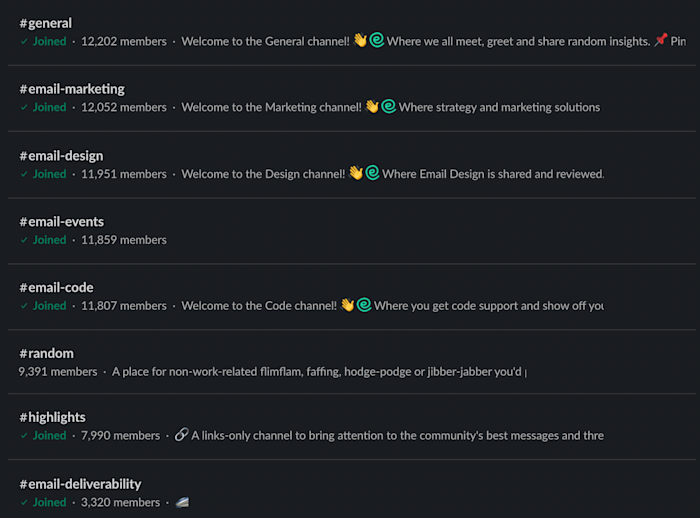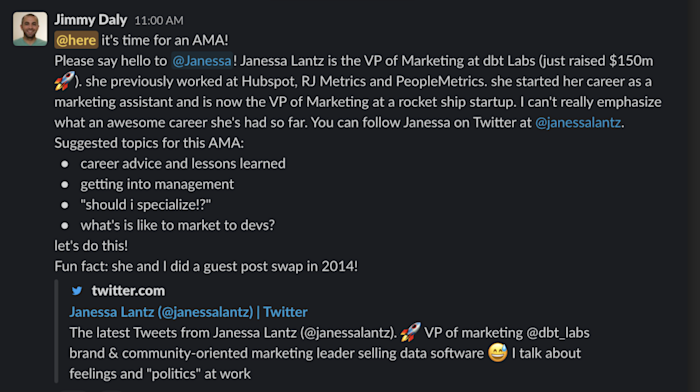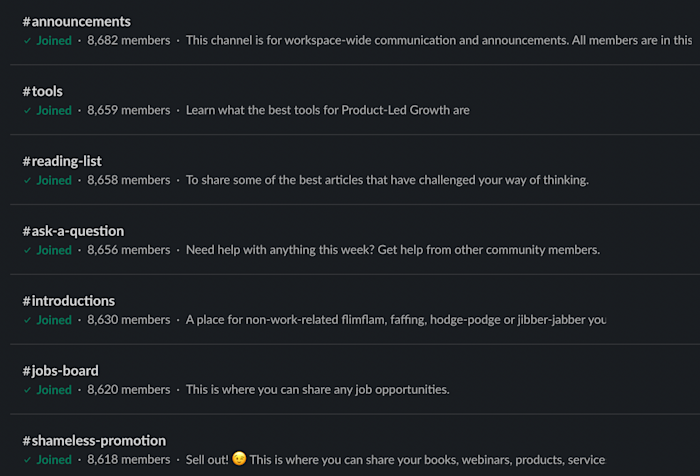If you want to go fast, go alone. If you want to go far, go with a Slack group for marketers?
Being part of a professional community can help you be better at your current job and grow your network for when it’s time for your next one. I wanted to get a sense of what marketing Slack groups were like, so I joined a few. I spent a week in each one—and here’s what I found.
My time undercover in Slack groups for marketers
In evaluating these groups, I tried to be as organized and data-driven as possible, but the reality is I was working with a tiny sample size. Still, I tried to establish a level playing field:
-
I joined groups without an entrance fee or a months-long waitlist. Groups with more screening may be more valuable than open ones. For example, the Online Geniuses group is popular by the numbers, but unless you pay up, you have to wait months to join. I decided to see what was available without those barriers to entry.
-
I measured engagement on up to 12 of the top channels in each group. If the Slack group automatically placed me in a set of channels, I left them as is. Some groups only defaulted to a channel or two, in which case I joined the top 12 by the number of members.
-
I counted the number of new posts and replies each day for five working days. I wanted to see what engagement looked like over a typical work week. At the end of the week, I calculated the average new daily posts and replies for each group.
In the end, I joined Email Geeks, Superpath, Product-Led Growth Community, and Growmance. I submitted my email for an invitation to Marketers Chat, but it never came. That makes me think it may not be live anymore.
I also want to give a disclaimer: my experiences and reviews are my own. If you’re in a Slack group and love it, that’s amazing! We all have a different opinion of what “valuable” looks like.

Email Geeks is a Slack group for email marketers, designers, and developers to “talk shop.” Viktor Edvardsson and Dylan Smith created the community, which has grown to more than 12,000 members, making it the largest group I reviewed. You don’t have to jump through a bunch of hoops to join—the only required info is your name, email, and a summary of your experience or interest in email marketing.
Since Email Geeks is the largest community in this bunch, it makes sense that it also has the most channels: 82 total, with a lot of city- and country-specific threads. In addition to email-related spaces, there are also channels for video games, travel, and other personal interest topics. There’s solid member coverage across channels, which means people venture past #general and #promotional.

What impressed me most about Email Geeks is how many new posts and replies there are every day: on average, 27 daily posts and 172 daily replies. Members regularly work through issues on long threads, and people seem happy to answer questions and offer advice.

Final thoughts: If you work in or adjacent to email, absolutely join this group. Email Geeks is consistently active and covers a range of topics that will help you expand your email-related knowledge and connect with folks in the field. Based on how many replies and conversations happen each day, I get the impression that members check the group regularly and work together in real-time to solve problems.
Content marketing Slack group: Superpath

Superpath is a free group (with an optional paid monthly membership that has some extra perks) geared toward content marketing. Jimmy Daly created the community and is still active in the group. And it’s more than just standard Slack conversations: you’ll get live Q&A sessions with featured guests (recently, Janessa Lantz, VP of Marketing at dbt Labs) and an exclusive newsletter. To join, you’ll have to provide work-related information, like your job title and whether you’re in-house, freelance, or agency.

There are 21 channels, almost all of which are focused on work. The most active channels cover content strategy, job postings, and those live “ask me anything” sessions, and there’s an average of 23 posts and 54 replies per day. One other big plus: Jimmy posts dozens of open jobs in content marketing each week, so it’s a great place to go if you’re looking for work—freelance or in-house.

When it comes to vibe, Superpath definitely feels like a kind and supportive place. Members are quick to jump in and offer words of advice or actionable suggestions, and the Slack group promotes inclusion.
Final thoughts: I’ve been in this group for a while, and I often recommended it to fellow writers. The hyper-focus on content marketing makes it great for content folks, and the separate spaces for niches within content (think: B2B and B2C, in-house and freelance) will help you find the group of people most likely to offer the support you need.

I included one group that I consider marketing-adjacent: Product-Led Growth Community. While it doesn’t focus solely on a marketing specialty, it has a clearly defined perspective: the Product-Led Growth Institute believes that sales and marketing need to work integrated with product teams.
Similar to other Slack groups, the PLG community has local-only channels as part of its 70-channel lineup. Joining these channels is a great way to network with local marketers, especially if you’re a remote worker who wants more collaboration. The #best-practices channel is consistently active with lots of questions and insights, and like most marketing Slack groups, there’s a promotion channel (called #shameless-promotion in this one!) to share your latest work.

If you post a question in the Product-Led Growth Community, you’ll likely get an answer: the group sees 19 new posts and 22 replies daily, putting it in line with other marketing Slack groups. The PLG site invites people to challenge perspectives to grow and learn, but they clarify that members need to treat everyone with dignity, decency, and respect—and that seems to be the case in the Slack group.

Final thoughts: This is a good place to find like-minded individuals if you believe in (or want to incorporate more) product-led growth. There are channels across a few specialties (like sales), but you won’t find marketing tactics, per se. Instead, it’s an excellent place to learn across teams or broaden your perspective.
Slack group for digital marketing: Growmance

I was really impressed with most of the Slack groups I joined—Growmance was the exception. It’s a group for digital marketing, growth hacking, and lead generation created by Audienti, a lead sourcing tool.
At first glance, Growmance seems compelling: there are over 11,000 members and 28 channels covering everything from general topics to specifics like social media marketing, affiliate marketing, PPC, and more.
Look a bit closer, though, and you’ll notice few people venture outside of the default channels. While the other groups had fairly even coverage across channels, Growmance goes from 11,205 members in #general to 98 members in #ppc.

Growmance was also the least active group by a long shot. Despite the number of members, there were only eight posts a day on average—with an average of one reply. One day, most of the new messages were the same message from the same user posted in every channel. There’s little discussion, and most posts are promotional.
Final thoughts: I’d skip this group. You could always try being the first person on the dance floor and be as engaging as you want others to be, but I don’t think you’ll make it very far here. The requirements to join aren’t particularly relaxed; it’s just that nobody’s super active on it. There doesn’t seem to be any community moderator to get the party started.
Find the perfect marketing Slack for you
I’ve been a part of a handful of Slack groups, so I thought I knew what I was getting into before I embarked on this experiment. But paying close attention to details helped me come to a few new realizations. If you want to find a community of marketers to learn from and grow with, these are my tips:
1. Go niche. Look for a group that focuses on a single specialty, like email marketing or content. If it’s a general marketing group, make sure there’s a strong philosophy or perspective to tie it all together (one you agree with, of course).
2. Ignore the member count. The largest Slack group I joined did have the most active community. But the second-largest group had the least. While you’re more likely to get a diverse perspective in a larger group, don’t knock an up-and-coming community because of small numbers. Instead, focus on engagement.
3. Check for even member coverage across channels. If the #general or default channel has 10,000 members and every other channel numbers in the hundreds, it’s a sign that most people never make it past the first day—you probably won’t find many real conversations happening.
If you haven’t found an online community (or at least a few virtual marketer friends), I suggest making it part of your career growth plan. Getting outside perspectives and opinions can help you make decisions and introduce you to resources you didn’t know existed. If you don’t know where to start, ask people on your team or in your network which communities they use. Then get out there and try a few on for size.
[adsanity_group align=’alignnone’ num_ads=1 num_columns=1 group_ids=’15192′]
Need Any Technology Assistance? Call Pursho @ 0731-6725516







